The River
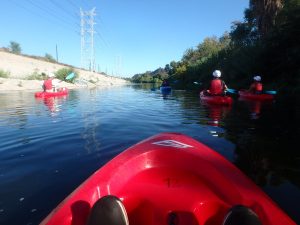 When you stand solitary on North Main Street next to the railroad tracks above the Los Angeles River all you feel is a deep sadness as you look down on a river that has been dramatically altered in a relatively short amount of time. You look down on a river that has been soiled by trash and has become a concrete waterway juxtaposed with brightly colored graffiti where those entrapped by the city, drugs, gangs and poverty territorially cry out with their markings.
When you stand solitary on North Main Street next to the railroad tracks above the Los Angeles River all you feel is a deep sadness as you look down on a river that has been dramatically altered in a relatively short amount of time. You look down on a river that has been soiled by trash and has become a concrete waterway juxtaposed with brightly colored graffiti where those entrapped by the city, drugs, gangs and poverty territorially cry out with their markings.
Electrical lines, bridges, rubble and old fences all decorate the banks of what was originally a small river that flowed near where 11 families settled in 1781 (they created irrigation ditches for their crops, drawing from the river) and gave the city its first name. If you do not happen to be on North Main Street, any of a number of bridges in this area will afford one the same views. Close your eyes and think back 100+ years to a time when this actually was a natural river, with more native trees and vegetation growing along its banks. Or, if your imagination has been corrupted beyond hope by the scene that lies in front of you, simply click here to see a picture of the LA River taken in 1900.
However, like a number of things in Los Angeles, this river is continuously reinventing itself. What is authentic here? Is there an authentic (whatever that means) experience on the LA River?
Ignore trying to find meaning in that, whatever it may be and focus on what the river delivers today – an oasis of calm among the hectic fast paced life of Los Angeles. And, in the summer at least, an in the moment enjoyable, memorable and unique experience on it’s waters from the seat of a kayak.
The river couldn’t have delivered enough water to be able to kayak it in the middle of summer 80+ years ago. Today water is processed up river in the Donald C. Tillman Water Reclamation Plant in Van Nuys at the Japanese Garden. Excess water is then released (tested as drinkable upon release); the water levels depend on how much water is being released at any given time.
 And the Los Angeles River will continue to evolve at the hands of humans. Just recently the river was recommended for one billion dollars (with most of the money coming from the Army Corps, the Department of the Interior and the U.S. Environmental Protection Agency) to remove some of the concrete, buildings and the invasive species that plague an 11 mile section of this waterway; these changes will be made along the river just north of downtown.
And the Los Angeles River will continue to evolve at the hands of humans. Just recently the river was recommended for one billion dollars (with most of the money coming from the Army Corps, the Department of the Interior and the U.S. Environmental Protection Agency) to remove some of the concrete, buildings and the invasive species that plague an 11 mile section of this waterway; these changes will be made along the river just north of downtown.
Over 100 years ago the river wasn’t paved on both sides and had a natural bottom. Because of a high water table and the way the river curves around the hills in Elysian Valley, the bottom of the river was never paved in a number of sections. The “containment” of the river was done in the late 1930’s to control the flow of water after the city sustained damage during a number of winter floods. Historically the river never had this much water during the middle of summer.
The river is approximately 51 miles in length – the stretch of water one is currently allowed to kayak on is about 2.5 miles.
The Experience
An activity that probably doesn’t come to mind when discussing Los Angeles is kayaking the LA River; but since the summer of 2013 select kayak trips are offered through LA River Kayak Safari company. This pleasant and mostly relaxing (with short adreniline bursts) kayak journey is in the middle of the urban jungle just north of downtown. Busy freeways literally cross over the river and surround it in many directions. A kayak ride here is a 180 degree opposite experience from fighting your towards downtown on the 5 during rush hour with thousands of other vehicles.
We met our guides at the tiny Oso Park (sits behind Elysian Park next to the 5 Freeway) including acomplished photographer Grove Pashley who co-founded the company in 2013. He calls the LA River home, almost literally – his house is right above the river and he can watch his guests float by from his back yard.
This is a residential part of Los Angeles sandwiched between the 5 freeway and the actual river – Dodger Stadium sits just on the other side of the nearby hills above the freeway.
Word about this ‘undiscovered’ part of Los Angeles has not yet gone out to International visitors – during our recent trip, the kayakers were all local. We soon hopped on bikes and rode the bicycle path along the greenway to the put in point where the kayaks were waiting for us on the edge of the concrete side of the river.
One would never suspect there are rapids on this river in the middle of the summer. But with water this high and plenty of rocks on the river bed we enjoyed a number of thrilling short whitewater stretches which became especially challenging with large rocks only inches below the water.
Considering the urban surroundings, it is amazingly peaceful here – with the calming sound of running water and at worst the occasional helicopter flying overhead. Plenty of vegetation grows in immediate proximity to the water. The diversity of birds that live along this stretch is surprising – we spotted several Great Blue Herons, white egrets and a number of smaller species. Seven species of fish live in the river including catfish and bass.
Several hours pass by quickly and by the time you reach the small ‘do not enter’ sign posted in the middle of the river you aren’t quite ready to leave the water.
Friends of the Los Angeles River (FOLAR)
Friends of the Los Angeles River (FOLAR) is an organization co-founded in 1986 by Lewis MacAdams (died in April 2020) which in part helps secure funding to restore and promote the river. Over the decades, Lewis has attended various meetings relating to the Los Angeles River. Whenever anyone at these meetings would refer to the river as a “flood control channel” Lewis would stand up and correct them by saying “Los Angeles River”.
Overtime FOLAR has certainly changed people’s perceptions of this river and were instrumental in securing government funds to help restore stretches of this waterway.
Folar also operates the cute little Frog Spot Visitor’s Center at 2825 Benedict Street – overlooking the river and the bicycle path (you will bike by this spot on your way to the put in point for the kayaks). The Frog Spot is only open on the weekends during summer from 8am to 4pm. You come here when you need a restroom, snacks and drinks, information about the river and or you can jump on their wifi network. Special events are held on certain Saturdays including live music.
More Information
For more information on kayaking the river during the summer months visit: www.lariverkayaksafari.org
For more information about FOLAR visit www.folar.org and for general restoration projects visit: www.lariver.org


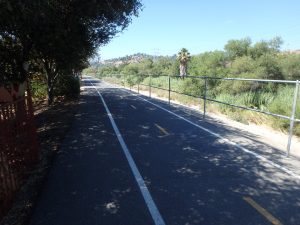
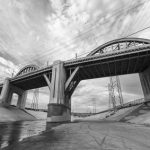
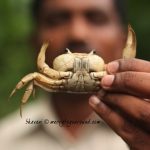

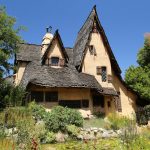
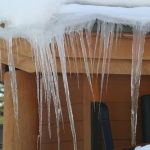
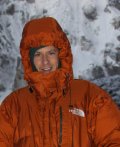
I think when you see things from a kayak, even a city, you notice different things than when you just walk the path beside the river. Sounds interesting!
Corinne – that is absolutely correct. And the same way with sailing as well